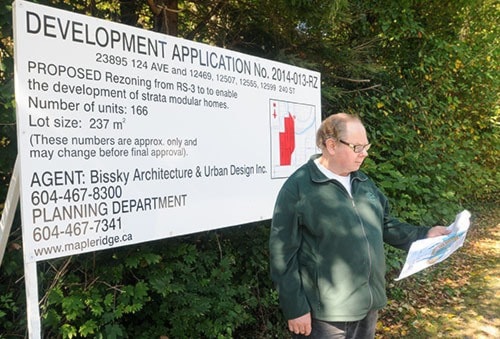Maple Ridge is working on a way to allow dozens of modular rancher-style homes along the South Alouette River.
Despite an audience opposed to the project on Tuesday, council rejected a staff recommendation to ditch an initial proposal to build 166 manufactured, rancher homes at 240th Street and 125th Avenue.
“It’s disappointing. They seem to be in love with the idea of modular homes as affordable housing for seniors,” resident Harvey Gigun said of council.
“If that was really their concern, modular homes for seniors could be built on almost any lot in Maple Ridge. So what’s the push to do it in the flood plain along the Alouette River?”
Council first rejected a staff recommendation to deny the project. Only Coun. Cheryl Ashlie and Mayor Ernie Daykin voted for that.
Instead, council told staff to work with Bissky Architecture and Urban Design and come up with another plan for the 34-acre site.
Couns. Mike Morden, Corisa Bell, Judy Dueck and Al Hogarth voted for that, while Daykin and Coun. Bob Masse and Ashlie voted against.
Morden said he wanted to see what the project looked like so he supported staff reviewing it again.
“It’s a difficult one, I agree. Sometimes you have look at some creative things.”
The proposal initially called for four-times the population density that’s currently allowed under the one-acre “estate-suburban residential designation.”
However, the total number of units has been reduced to 138, Gigun added.
A staff report says the initial proposal would bring small-lot development to a rural area where there are now one-acre properties.
The site lies outside Maple Ridge’s urban boundary.
Allowing the project, which seeks a four-fold increase in density, could be a precedent for estate suburban residential throughout rural Maple Ridge, said Ashlie.
“I think council wants to look at the impact [on the official community plan] on its totality. You’re changing the landscape of the OCP and our intentions of it,” she added.
“Five hundred and twelve acres are now open for this type of development. How do we say yes to this and not to the others that come forward?
“How are we planning for this?
Ashlie said she’d like to live in such a complex, “but I have to think of the consequences to the rest of the community.”
But Dueck said high density development in other similar areas could only happen if other developers provided extras, such as park land. Council’s done it before, she added.
Council at least should get all the information about the proposal, she added.
“We’re not dealing with the facts right now,” Dueck said.
“I would like to see it given at least that opportunity.”
Staff also say allowing urbanization of areas in north Maple Ridge would mean Thornhill, the area east of 248th Street, would no longer be the next area for suburban expansion. Development also would take a hopscotch pattern.
When the 2006 official community plan was being written, “significant dialogue” took place over what would be next area for suburban growth and Thornhill, rather than areas to the north, would be the next area once Maple Ridge’s population hit 100,000.
Staff will now work with the developer to see if a lower population density for the project is possible, then report back to council.
“I guess it will come back with some form of higher density than what’s there,” Daykin said Wednesday.
But allowing high population density in the estate-suburban residential designation would be “would be a huge amendment.”
That requires more work than something just based on two applications, Daykin said.
“Although that’s a broader discussion. That’s why I struggled with it and didn’t support it.”
Council, at the same meeting, however, decided to follow staff and rejected another application by Bissky Architecture and Urban Design, to put 41 lots on land where there also are now one-acre lots on estate-suburban residential land at 24205 Alouette Rd.
Bell, Hogarth and Morden opposed that, but Daykin, Masse, Dueck and Ashlie voted for the denial.
That property is also outside the urban boundary.
Instead, staff will review the entire estate-suburban residential designation to see if that can be developed at higher density.
That review won’t be complete for more than a year, after the Hammond and Albion flats area plans are complete.
